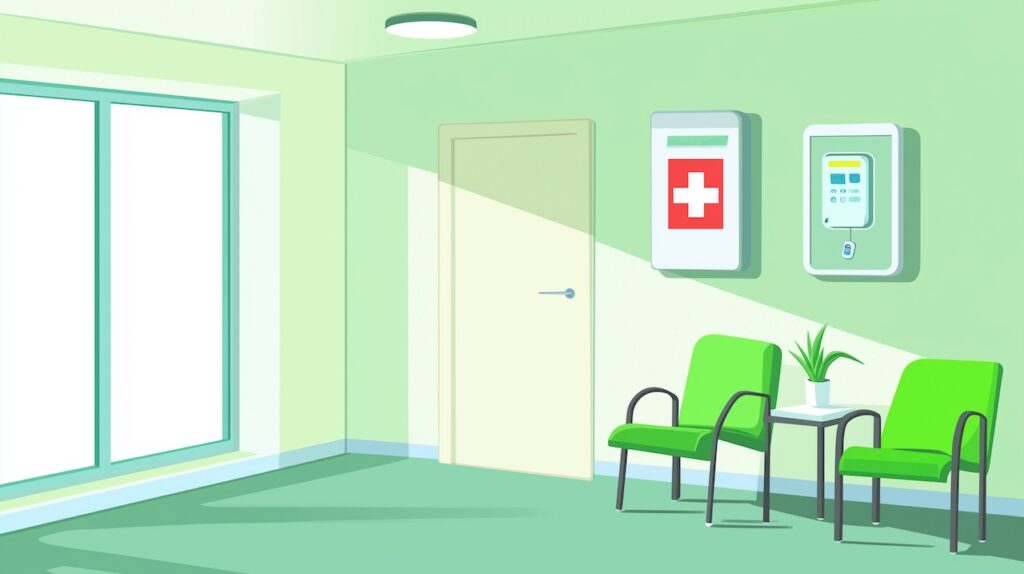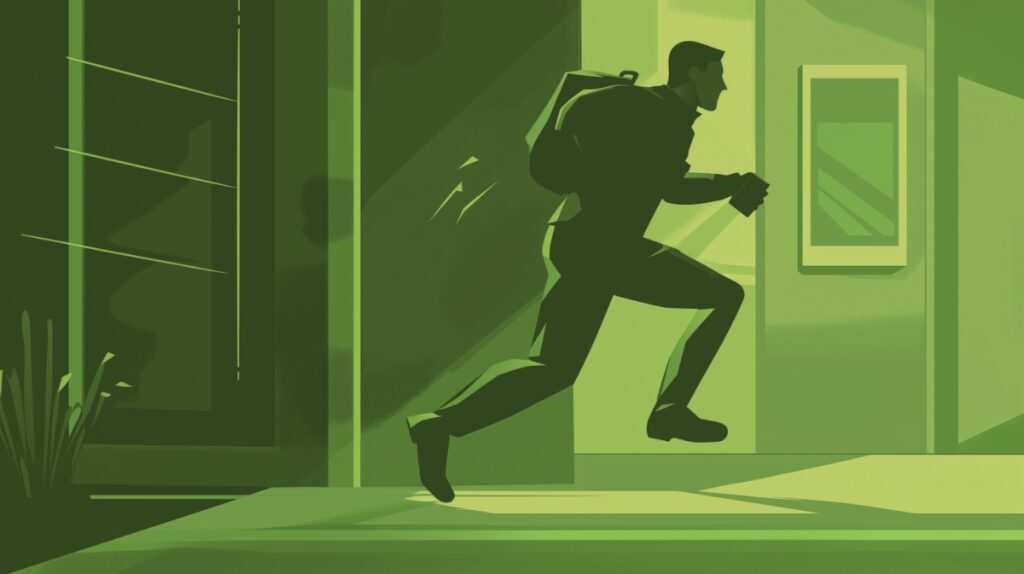Correctly storing your automated external defibrillators (AEDs) is very important.
Proper storage ensures the AED is secure while remaining easy to find and access.
It can also protect these pricey yet priceless life-saving devices from damage due to environmental conditions.

This guide explores the best ways to store your AED. We’ll cover options for inside and outside storage and considerations and best practices for keeping the AED secure, easy to see, and working well.
Key Considerations When Choosing the Best AED Storage Option
When selecting an AED storage solution, there are three critical factors to keep in mind:
- Security: AED cabinets should have features that prevent theft and tampering while allowing fast emergency access.
For example, alarmed units that sound when opened deter unauthorized use. Sturdy locking mechanisms can also keep defibrillators secure but easily accessible to trained responders in environments where security outweighs accessibility. - Visibility: Storing AEDs in highly visible locations with clear signage is crucial for quick retrieval during a cardiac arrest.
Wall-mounted cabinets in high-traffic areas make defibrillators easy to find. Eye-catching labels and markers can help guide people rapidly to the AED when every second matters. - Environmental Protection: Shielding AEDs from temperature extremes, moisture, and dust minimizes maintenance requirements and can ensure that your AEDs are reliable and ready to use at a moment’s notice.
For outdoor placement, weather-resistant enclosures with insulation and temperature regulation are essential. However, indoor cabinets should also protect from hazards, such as spills, fire suppression systems, and temperature exposure in non-climate-controlled areas.
By prioritizing security, visibility, and environmental protection when choosing AED storage, you can be confident that your life-saving devices will be accessible and functional in an emergency.
The right cabinet or enclosure keeps defibrillators secure, easy to locate, and safeguarded from damaging elements.
Indoor AED Storage Options: Two Types for Added Flexibility

When choosing indoor defibrillator storage solutions, wall-mounted cabinets and portable carrying cases are leading options, offering secure accessibility and easy mobility in offices, schools, and public buildings.
Wall-Mounted Cabinets
Wall-mounted AED cabinets come in various types to suit different needs and budgets:
- Standard wall cabinets: These basic, budget-friendly cabinets are made of durable plastic or metal and feature a clear window for visibility.
- Alarmed wall cabinets: Equipped with an audible alarm that sounds when opened, these mid-range cabinets deter theft and unauthorized access.
- Stainless steel cabinets: Sleek and professional, stainless steel cabinets are sturdy, easy to clean, and come at a premium price point.
- Locking wall cabinets: Built-in locks provide extra security while allowing quick emergency access. Prices range from affordable to high-end, depending on features.
- Recessed wall cabinets: Recessed cabinets are installed into the wall for a flush-mounted look to save space, blend in, or meet accessibility requirements. They range from moderately priced to more expensive.
- Wall cabinets with strobe lights: When opened, these premium cabinets activate a bright strobe light to alert nearby people that the AED is being accessed.
Portable Carrying Cases for AED Mobility
Portable carrying cases provide a convenient solution for transporting AEDs to various locations, ensuring quick access in emergencies.
These cases are designed to protect the defibrillator and its accessories while making it easy to carry the device wherever it’s needed.
They can also be easily stored inside existing storage for other medical equipment, such as first aid kits, or near emergency gear, such as fire extinguishers, while taking up minimal space.
Portable AED carrying cases also offer some unique benefits over wall-mounted cabinets in terms of materials and features, such as:
- Durable construction from high-quality, impact-resistant materials like hard plastic or sturdy nylon to protect the AED during transport.
- Lightweight and compact designs for easy storage in various locations without taking up much space.
- Waterproof or water-resistant protection for indoor areas with frequent water exposure, such as near indoor pools or in gyms.
- Customizable compartments with adjustable foam inserts can be tailored to fit specific AED models and accessories.
- Comfortable carrying options such as shoulder straps or handles to transport the AED over longer distances quickly.
- Clear labelling on cases makes them easily recognizable as containing an AED in emergencies.
When selecting an indoor AED storage solution, consider factors like accessibility, security, and mobility.
Wall-mounted cabinets keep defibrillators visible and secure, while portable cases allow easy transport as needed.
The right choice depends on your specific environment and requirements.
Outdoor AED Storage Solutions: Features to Consider
Outdoor AED storage solutions must protect defibrillators from harsh weather and extreme temperatures.
Weather-resistant cabinets and enclosures designed specifically for outdoor use are essential to ensure AEDs remain accessible and functional when needed most.

These rugged storage solutions are engineered to withstand challenging environmental conditions, maintaining AED accessibility and functionality in emergencies.
When choosing the best option for your needs, look for automated external defibrillator storage options with the following traits or features.
Durable Construction Materials
Weather-resistant AED cabinets are typically constructed from noncorrosive fibreglass, which provides excellent durability and resistance to moisture, UV rays, and temperature fluctuations.
This lightweight yet strong material is ideal for outdoor enclosures mounted on walls or poles.
Environmental Protection Features
These specialized cabinets are designed to shield AEDs from various environmental factors, including:
- Extreme temperatures: Insulated cabinets maintain stable internal temperatures in hot or cold climates.
- Wind and rain: Sealed designs prevent water intrusion, keeping AEDs dry and functional.
- Dust and debris: Tight-fitting doors and gaskets keep out contaminants.
- Snow and ice: Heated options prevent freezing in cold weather.
Temperature Control Options
For areas with extreme temperatures, weather-resistant cabinets can be equipped with built-in heating or cooling systems.
These options maintain a stable temperature inside the cabinet, preventing damage to the AED, its battery, or the AED paddles.
Robust Security Measures
Outdoor AED cabinets often include security features to prevent theft or unauthorized access.
Sturdy locking mechanisms keep the AED secure while allowing quick emergency access.
Some models feature audible alarms or strobe lights that activate when the cabinet is opened, drawing attention to the AED’s location and deterring potential thieves.
Flexible Placement or Mounting Options and Excellent Visibility
Outdoor AED enclosures should be clearly visible and identifiable, even from a distance.
Many cabinets feature bright colours (such as red or yellow) and prominent AED signage to make them easily recognizable.
Placing these cabinets in high-traffic areas near building entrances, parking lots, or outdoor recreation spaces ensures maximum visibility and accessibility.
Many outdoor storage options are intended to be mounted or placed in a particular manner, making the best option for your needs highly dependent on the intended placement.
For example, a wall-mounted case might not offer options for pole mounting, while a case with temperature control options might require different power access requirements than a standard case.
Investing in weather-resistant cabinets and enclosures specifically designed for outdoor use gives you confidence that your AEDs will be protected from the elements and ready to save lives when every second counts.
Security Measures for AED Storage
Implementing effective security measures is crucial for protecting your AED investment and ensuring the device remains accessible during emergencies.
Choosing an AED cabinet with alarm options can help, but they work best when paired with strategic theft prevention techniques to help deter unauthorized access and secure your defibrillator.
AED Security Basics: Alarmed Cabinets
Alarmed AED cabinets provide an added layer of security by emitting a loud 80-120 decibel alarm and activating a flashing strobe light when opened.
The alarm and strobe immediately draw attention to the AED’s location, deterring theft or tampering while allowing easy access in an emergency.

These cabinets are typically constructed from durable materials like cold-rolled steel and have a scratch-resistant acrylic window for clear visibility of the AED inside.
They offer a reliable storage option that balances security and accessibility while maintaining compatibility with popular AED models.
Theft Prevention Strategies: The Key to AED Security
In addition to using alarmed cabinets, implementing these best practices can help prevent AED theft:
- Choose tamper-resistant enclosures: To deter vandalism and forced entry, opt for sturdy cabinets made from high-quality, break-resistant materials like steel or polycarbonate.
- Implement access control: Use reliable locking mechanisms, such as key locks or electronic access systems, to restrict AED access to authorized personnel only. Maintain a strict key management protocol.
- Install in high-visibility areas: To discourage theft attempts, place AED storage units in well-lit, high-traffic locations with good visibility. Potential thieves are less likely to target devices in busy, easily observable areas.
- Utilize security cameras: Position surveillance cameras near AED storage locations to monitor activity, deter criminals, and provide evidence in case of theft.
- Conduct regular inspections: Frequently check AED cabinets for signs of tampering or damage. Address any issues promptly to maintain the storage unit’s integrity and security.
- Raise awareness: Educate staff and the public about the life-saving importance of AEDs and the consequences of theft. Encourage staff and community vigilance in reporting suspicious activity near storage units.
By combining alarmed cabinets with these theft prevention strategies, you can create a comprehensive, multifaceted security plan that keeps your AED safe, accessible, and ready to save lives while minimizing the risk of vandalism, damage, or theft.
Maintenance and Inspection of AED Storage Units
Just as inspections and maintenance can ensure that AEDs are always ready to use at a moment’s notice, regular maintenance and inspection of AED storage units are powerful tools for ensuring that AEDs are accessible and protected at all times.
Establishing a comprehensive upkeep routine helps identify and address issues promptly, giving you peace of mind that your life-saving devices are always ready for use.
Establishing a Regular Check Protocol
To keep your AED storage solution in top condition, implement a consistent check protocol that includes thorough inspections at least once a month.

While exact considerations will vary based on the features and design of your AED storage solution, this six-step process should cover the basics for most models.
Each month, evaluate the following:
- Cabinet or enclosure integrity: Examine the storage unit for any signs of damage, such as cracks, dents, or corrosion. Ensure hinges, locks, and seals are functioning properly.
- AED presence and condition: Verify the defibrillator in the storage unit and visually inspect it for any apparent damage or defects.
- Accessories and supplies: Check that all necessary accessories, such as pads and batteries, are present and within expiration dates.
- Signage and visibility: Confirm that AED signage is clear, visible, and in good condition, making it easy to locate the storage unit.
- Alarm and monitoring systems: Test any alarms or monitoring devices to ensure they function correctly and have adequate battery life.
- Environmental controls: Assess the storage unit’s temperature, humidity, and cleanliness, ensuring it meets manufacturer recommendations for the AED and that any built-in climate control options function properly.
Document each inspection thoroughly in a log book or digital record, noting the date, condition of the storage unit and AED, and any corrective actions taken.
Promptly address any issues discovered during inspections, such as repairing damage, replacing batteries, or updating software. Regularly test and maintain environmental controls, like heating or cooling systems.
This meticulous record-keeping provides evidence of compliance with regulations and best practices, and a rapid response to any issues will minimize troubles later.
AED Wall Cabinet Cleaning and Upkeep Best Practices
Establish a cleaning and maintenance schedule in addition to regular inspections to keep your AED storage solution in optimal condition.
Use mild detergents and soft cloths to wipe down the storage unit’s interior and exterior surfaces, removing dust, dirt, and debris.
Pay extra attention to hinges, locks, and seals to prevent damage or corrosion.
In most cases, you’ll want to avoid harsh cleaners or abrasives.
If you need to remove stubborn stains, graffiti, or other hard-to-remove items, consult the manufacturer for recommendations and spot-test any solution to ensure that removal won’t result in significant damage.
If your AED storage case has advanced features such as alarms, climate control, or electronic access control, consider having your storage professionally serviced annually to identify and address any wear or hidden issues.
By implementing a robust maintenance and inspection protocol, cleaning and upkeep best practices, and efficient documentation processes, you can ensure your AED storage solution remains in top condition, and there are no surprises to deal with during already stressful emergencies.
Final Thoughts
Proper AED storage is critical for ensuring these life-saving devices are accessible and functional during emergencies.
With a solid understanding of the critical aspects of AED storage, including indoor and outdoor options, security measures, visibility guidelines, and maintenance protocols, you’re now well-equipped to implement the strategies and best practices that could save lives.
Investing in the right AED storage solution is crucial in protecting your family, community, or workspace and preparing for cardiac emergencies.
Contact us at CPAP Supply today for expert guidance on selecting the ideal storage option tailored to your specific needs.
We can help you navigate the various choices and find the perfect solution to keep your AEDs secure, accessible, and ready for action when every second counts.
References:
- Emergency Medical Journal: Integrating and maintaining automated external defibrillators and emergency planning in community sport settings: a qualitative case study
- U.S. Occupational Safety and Health Administration: Automated External Defibrillators (AEDs)
- Resuscitation Plus: Strategic placement of automated external defibrillators (AEDs) for cardiac arrests in public locations and private residences
- Resuscitation Plus: Factors affecting public access defibrillator placement decisions in the United Kingdom: A survey study
- AED Team: What should I look for when selecting an outdoor AED storage solution?
- Resuscitation Council UK: A Guide to Automated External Defibrillators (AEDs) [PDF]
- Avive: AED Placement Requirements & Best Practices

